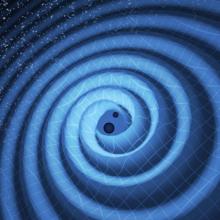An international collaboration of scientists identify a second gravitational wave event in the data from Advanced LIGO detectors
While the celebrations for the first detection of gravitational waves are still ringing down, we are excited to announce the observation of yet another binary black hole merger by LIGO. On December 26, 2015 at 09:09AM IST the LIGO detectors in Hanford, Washington and Livingston, Louisiana detected a signal from the coalescence of two black holes, with masses 14 and 8 times the mass of the sun, merging into a more massive, rapidly rotating black hole that is 21 times the mass of the sun. The event happened approximately 1.4 billion years ago. During this process, which lasted in LIGO's frequency band for about a second, a quantity of energy roughly equivalent to the mass of the sun was radiated as gravitational waves. In comparison, only a tiny fraction of the sun's mass gets converted to light over its entire lifetime.
Compared to the black holes in the first merger event announced in February 2016, the present one is much less massive. Detection of such events is however far more challenging, as these signals are intrinsically weaker and the power is distributed over a longer stretch of time, hiding the signal deep inside the noise. The group of Sanjeev Dhurandhar at IUCAA, Pune did foundational work on developing the data-analysis techniques used to detect these weak signals buried in the detector noise. The group at RRI, Bangalore led by Bala R. Iyer (currently at ICTS-TIFR) in collaboration with a group of French scientists pioneered the theoretical modeling of gravitational-wave signals from orbiting black holes. “State of the art data analysis infrastructure built on highly accurate waveform models based on general relativity was a key element that complemented the unforgiving experiment to make the discovery. Only because we knew well the waveform from the system we were looking for, could we first detect it and subsequently characterize it better,” said Iyer.
ICTS scientists, led by P. Ajith, played a leading role in the theoretical modeling of gravitational waves from merging black hole systems by combining mathematical calculations with large-scale supercomputer simulations. The ICTS group also significantly contributed to obtaining estimates of the mass and spin of the final black hole, and the amount of energy radiated as gravitational waves. They were also actively involved in testing Einstein’s theory of general relativity using the LIGO observations. Some of the computations needed for deciphering the discovery were performed using ICTS’s high-performance computing facilities.
39 researchers from India (including 7 from ICTS) have been involved in this discovery through the IndIGO consortium, which includes scientists from 9 institutions -- CMI Chennai, ICTS-TIFR Bangalore, IISER Kolkata, IISER Trivandrum, IIT Gandhinagar, IPR Gandhinagar, IUCAA Pune, RRCAT Indore and TIFR Mumbai. The Indian groups contributed to the development of data analysis pipelines, to developing and implementing methods to test general relativity, to distinguishing real gravitational wave events from instrumental artifacts, and in the search for electromagnetic counterparts of the gravitational wave events.
Two detections in quick succession, well before the detectors reaching their target sensitivity, accentuates that there is a whole new world out there to explore with gravitational waves. Advanced LIGO’s next data-taking run will begin in a few months. By then, further improvements in detector sensitivity are expected to allow LIGO to reach as much as 1.5 to 2 times more of the volume of the universe. The Advanced Virgo detector (Italy) is expected to join in the latter half of the upcoming observing run. The KAGRA detector is being commissioned in Japan. In addition, the LIGO-India -- a Indo-US joint observatory to be located in India -- is expected to be operational in the early next decade.
An international collaboration of scientists
The LIGO Observatories are funded by the National Science Foundation (NSF), and were conceived, built, and are operated by Caltech and MIT. The discovery, accepted for publication in the journal Physical Review Letters, was made by the LIGO Scientific Collaboration (LSC) and the Virgo Collaboration using data from the two LIGO detectors.
The LSC is a group of more than 1,000 scientists from universities around the United States and in 14 other countries. More than 90 universities and research institutes in the LSC develop detector technology and analyze data; approximately 250 students are strong contributing members of the collaboration. Virgo research is carried out by the Virgo Collaboration, consisting of more than 250 physicists and engineers belonging to 19 different European research groups.
ICTS researchers were benefitted by the support from the Department of Atomic Energy, the Department of Science and Technology, the Science & Engineering Research Board, the Simons Foundation, the Airbus Foundation, the Infosys Foundation and the Max Planck Society.
Media contact
Parul Sehgal
International Centre for Theoretical Sciences, Tata Institute of Fundamental Research, Bangalore
E-mail: parul . sehgal @ icts . res . in
Tel. +91 80 4653 6011, +91 80 6730 6011, Mob. +91 78296 49179
Associated scientific event: Observing black holes
17 June 2016 (Friday), 2:30 pm
ICTS campus, Hessaraghatta, North Bangalore
Speakers:
Ramesh Narayan (Harvard University): Black Hole Astrophysics
Parameswaran Ajith (ICTS): LIGO Observations of Binary Black Holes
Nathan Johnson-McDaniel (ICTS): Properties and Implications of LIGO’s First Crop of Binary Black Holes


